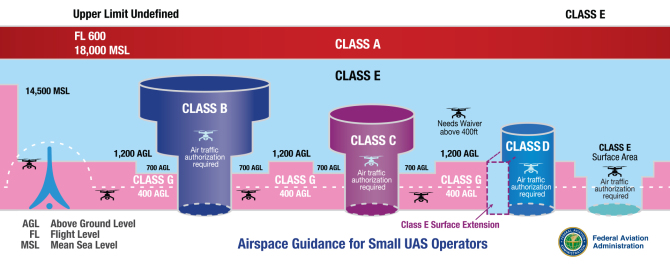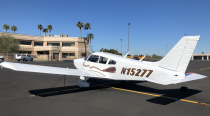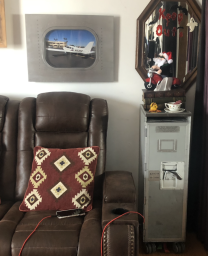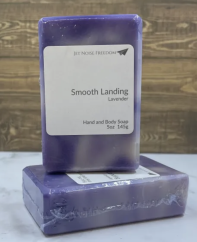
Airspace
Congress empowered the FAA Administrator to regulate the use of navigable airspace as he or she in the exercise of his or her discretion deems necessary in order to assure the safety of aircraft and the efficient utilization of such airspace
FAA accomplished this with 14 CFR Part 71 which establishes the airspace
14-1-2. DEFINITIONS
a. CONTROLLED AIRSPACE. An airspace of defined dimensions within which ATC service is provided to IFR flights and to VFR flights in accordance with the airspace classification.
1. Controlled airspace is a generic term that covers Class A, Class B, Class C, Class D, and Class E airspace areas.
2. Controlled airspace is also that airspace within which all aircraft operators are subject to certain pilot qualifications, operating rules, and equipment requirements in 14 CFR part 91 (for specific operating requirements, please refer to 14 CFR part 91). For IFR operations in any class of controlled airspace, a pilot must file an IFR flight plan and receive an appropriate ATC clearance. Each Class B, Class C, and Class D airspace area designated for an airport contains at least one primary airport around which the airspace is designated (for specific designations and descriptions of the airspace classes, please refer to 14 CFR part 71).
3. Controlled airspace in the United States is designated as follows:
(a) CLASS A AIRSPACE AREA. Generally, that airspace from 18,000 feet MSL up to and including FL 600, including the airspace overlying the waters within 12 nautical miles (NM) of the coast of the 48 contiguous States and Alaska. Unless otherwise authorized, all persons must operate their aircraft under IFR.
(b) CLASS B AIRSPACE AREA. Generally, that airspace from the surface to 10,000 feet mean sea level (MSL) surrounding the nation's busiest airports in terms of airport operations or passenger enplanements. The configuration of each Class B airspace area is individually tailored and consists of a surface area and two or more layers, and is designed to contain all published instrument procedures. An ATC clearance is required for all aircraft to operate in the area, and all aircraft that are so cleared receive separation services within the airspace. The cloud clearance requirement for VFR operations is “clear of clouds."
(c) CLASS C AIRSPACE AREA. Generally, that airspace from the surface to 4,000 feet above the airport elevation (charted in MSL) surrounding those airports that have an operational control tower, are serviced by a radar approach control, and that have a certain number of IFR operations or passenger enplanements. Although the configuration of each Class C area is individually tailored, the airspace usually consists of a surface area with a 5 NM radius, an outer circle with a 10 NM radius that extends from no lower than 1,200 feet up to 4,000 feet above the airport elevation. Each person must establish two-way radio communications with the ATC facility providing air traffic services prior to entering the airspace and thereafter maintain those communications while within the airspace.
(d) CLASS D AIRSPACE AREA. Generally, that airspace from the surface to 2,500 feet above the airport elevation (charted in MSL) surrounding those airports that have an operational control tower. The configuration of each Class D airspace area is individually tailored and when instrument procedures are published, the airspace will normally be designed to contain the procedures. Arrival extensions for instrument approach procedures may be Class D or Class E airspace. Unless otherwise authorized, each person must establish two-way radio communications with the ATC facility providing air traffic services prior to entering the airspace and thereafter maintain those communications while in the airspace. No separation services are provided to VFR aircraft.
(e) CLASS E AIRSPACE AREA. Generally, if the airspace is not Class A, Class B, Class C, or Class D, and it is controlled airspace, it is Class E airspace. The types of Class E airspace areas are:
(1) Surface Area Designated for an Airport - When designated as a surface area for an airport, the airspace will be configured to contain all instrument procedures.
(2) Extension to a Surface Area - There are Class E airspace areas that serve as extensions to Class B, Class C, Class D, and Class E surface areas designated for an airport. Such airspace provides controlled airspace to contain standard instrument approach procedures without imposing a communications requirement on pilots operating under VFR.
(3) Airspace Used for Transition - There are Class E airspace areas beginning at either 700 or 1,200 feet AGL used to transition to/from the terminal or en route environment.
(4) En Route Domestic Areas - There are Class E airspace areas that extend upward from a specified altitude and are en route domestic airspace areas that provide controlled airspace in those areas where there is a requirement to provide IFR en route ATC services but the Federal airway system is inadequate.
(5) Federal Airways - The Federal airways are Class E airspace areas and, unless otherwise specified, extend upward from 1,200 feet to, but not including, 18,000 feet MSL. The colored airways are green, red, amber, and blue. The VOR airways are classified as Domestic, Alaskan, and Hawaiian.
(6) Unless designated at a lower altitude, Class E airspace begins at 14,500 feet MSL to, but not including 18,000 feet MSL overlying: the 48 contiguous States including the waters within 12 miles from the coast of the 48 contiguous States; the District of Columbia; Alaska, including the waters within 12 miles from the coast of Alaska, and that airspace above FL 600; excluding the Alaska peninsula west of long. 160°00'00"W., and the airspace below 1,500 feet above the surface of the earth unless specifically so designated.
(7) Offshore/Control Airspace Areas. Airspace areas beyond 12 NM from the coast of the United States, wherein ATC services are provided.
b. UNCONTROLLED AIRSPACE.
1. CLASS G AIRSPACE AREA. Airspace that has not been designated as Class A, Class B, Class C, Class D, or Class E airspace.
Adobe Acrobat document [12.7 MB]
The FAA may impose Temporary Flight Restrictions (TFRs) by Notice to Airmen (NOTAM)
The FAA may establish Special Flight Rules Areas (SFRAs) where restrictions to flight apply
Security Control of Air Traffic and Air Navigation Aids (SCATANA)
September 9, 1950
Congress directed the FAA’s forerunner, the CAA, to develop and implement plans for security control of air traffic whenever US security is endangered
Developed in cooperation with the Department of Defense (DoD)
Updated over the years
Not used until 9-11 when the President and Congress declared the entire US airspace a National Security Airspace and implemented SCATANA
National Security and Interception Procedures
FAA airspace allocation regulations, like all other FARs and other federal regulations are subject to requirements of the federal Administrative Procedure Act (APA) which requires that the agency first establish a proposed regulatory change as a Notice of Proposed Rulemaking (NPRM) in the Federal Register and provide a reasonable opportunity for public comment before adoption (except for emergencies)
If topic is highly controversial FAA may first issue an Advance Notice of Proposed Rulemaking (ANPRM) to help focus issues
APA allows citizens to petition the FAA to change existing regulations
AOPA often weighs in
The FAA often provides for public hearings if topic is controversial
Wilderness Airspace
All aircraft are requested to maintain an altitude no lower than 2,000 feet above
1987 FAA and Department of the Interior deemed Special Federal Aviation Regulations (SFARs) over the Grand Canyon imposing flight free zones
Dispute Resolution
Resort to court is rarely useful in controversies
If FAA fails to follow procedures court may set aside agency’s decision until the agency follows proper procedure
Unless the decision was arbitrary or capricious abuse of the agency’s discretion, and there was some rational basis for the decision, the court will not reverse the decision
Once the agency announces its final decision the courts are unlikely to overturn it and only recourse may be to petition Congress
Contact Me
Sarah Nilsson, J.D., Ph.D., MAS
602 561 8665
You can also fill out my
Get Social with Me
Legal Disclaimer
The information on this website is for EDUCATIONAL purposes only and DOES NOT constitute legal advice.
While the author of this website is an attorney, she is not YOUR attorney, nor are you her client, until you enter into a written agreement with Nilsson Law, PLLC to provide legal services.
In no event shall Sarah Nilsson be liable for any special, indirect, or consequential damages relating to this material, for any use of this website, or for any other hyperlinked website.
Steward of
I endorse the following products
KENNON (sun shields)









